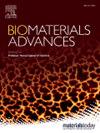Engineered bioactive glass-chitosan hybrid for dual tissue and bone regeneration multifunctional healing
IF 5.5
2区 医学
Q2 MATERIALS SCIENCE, BIOMATERIALS
Materials Science & Engineering C-Materials for Biological Applications
Pub Date : 2025-05-08
DOI:10.1016/j.bioadv.2025.214340
引用次数: 0
Abstract
The treatment of complex wounds, particularly those arising from conditions such as diabetes or trauma, presents a significant clinical challenge. These wounds often necessitate long-term care for soft tissue and bone repair, creating an urgent need for multifunctional wound dressings. This study introduces a chitosan-silica hybrid dressing enhanced with bioactive glass (BG), specifically designed to address this need. The hybrid material achieves molecular bonding through coupling agents, with the organic chitosan component providing swelling and hemostatic effects, while the inorganic silica and BG release ions (Si4+, Ca2+), promoting tissue regeneration and bone healing. With a controlled degradation profile (lasting 3 to 6 months in-vitro), the dressing is ideal for chronic wound management. Experimental results demonstrate excellent biocompatibility, no inflammatory response, and strong hemostatic properties due to the positively charged chitosan and cations. Adding BG significantly enhances bone regeneration, positioning this chitosan-silica hybrid as a promising solution for the simultaneous repair of soft tissue and bone.
工程生物活性玻璃-壳聚糖复合材料用于双组织和骨再生的多功能愈合
复杂伤口的治疗,特别是由糖尿病或创伤等疾病引起的伤口的治疗,是一项重大的临床挑战。这些伤口通常需要长期的软组织护理和骨修复,因此迫切需要多功能伤口敷料。本研究介绍了一种用生物活性玻璃(BG)增强的壳聚糖-二氧化硅混合敷料,专门设计用于解决这一需求。该杂化材料通过偶联剂实现分子键合,有机壳聚糖组分具有消肿止血作用,无机二氧化硅和BG释放离子(Si4+、Ca2+),促进组织再生和骨愈合。该敷料具有可控的降解特性(在体外持续3至6个月),是治疗慢性伤口的理想敷料。实验结果表明,壳聚糖和阳离子具有良好的生物相容性、无炎症反应和强止血性能。添加BG可以显著增强骨再生,将这种壳聚糖-二氧化硅混合物定位为同时修复软组织和骨骼的有前途的解决方案。
本文章由计算机程序翻译,如有差异,请以英文原文为准。
求助全文
约1分钟内获得全文
求助全文
来源期刊
CiteScore
17.80
自引率
0.00%
发文量
501
审稿时长
27 days
期刊介绍:
Biomaterials Advances, previously known as Materials Science and Engineering: C-Materials for Biological Applications (P-ISSN: 0928-4931, E-ISSN: 1873-0191). Includes topics at the interface of the biomedical sciences and materials engineering. These topics include:
• Bioinspired and biomimetic materials for medical applications
• Materials of biological origin for medical applications
• Materials for "active" medical applications
• Self-assembling and self-healing materials for medical applications
• "Smart" (i.e., stimulus-response) materials for medical applications
• Ceramic, metallic, polymeric, and composite materials for medical applications
• Materials for in vivo sensing
• Materials for in vivo imaging
• Materials for delivery of pharmacologic agents and vaccines
• Novel approaches for characterizing and modeling materials for medical applications
Manuscripts on biological topics without a materials science component, or manuscripts on materials science without biological applications, will not be considered for publication in Materials Science and Engineering C. New submissions are first assessed for language, scope and originality (plagiarism check) and can be desk rejected before review if they need English language improvements, are out of scope or present excessive duplication with published sources.
Biomaterials Advances sits within Elsevier''s biomaterials science portfolio alongside Biomaterials, Materials Today Bio and Biomaterials and Biosystems. As part of the broader Materials Today family, Biomaterials Advances offers authors rigorous peer review, rapid decisions, and high visibility. We look forward to receiving your submissions!

 求助内容:
求助内容: 应助结果提醒方式:
应助结果提醒方式:


